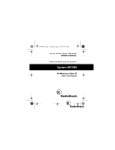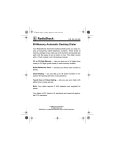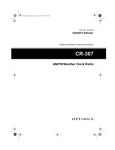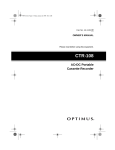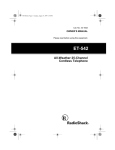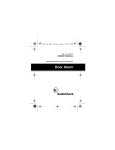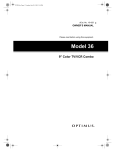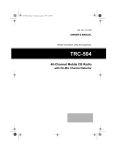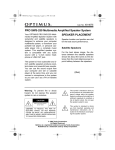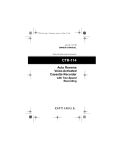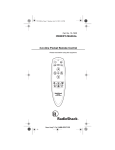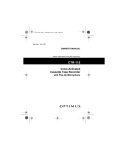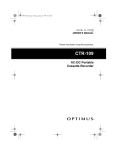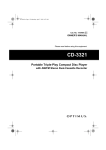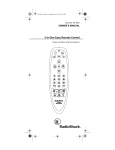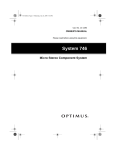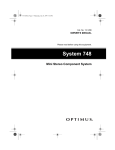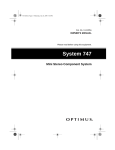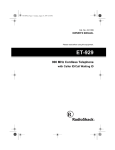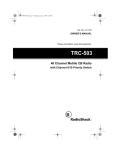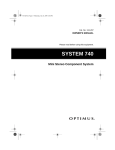Download Optimus 16-132 User's Manual
Transcript
16-132.fm Page 1 Tuesday, July 20, 1999 8:46 AM Cat. No. 16-132 OWNER’S MANUAL Please read before using this equipment. 5-Inch Black and White Television with AM/FM Stereo and Cassette Recorder with AM/FM Radio 16-132.fm Page 2 Tuesday, July 20, 1999 8:46 AM FEATURES Your Optimus 5-Inch Black and White Television lets you watch TV just about anywhere. It also lets you make live audio recordings or record from the radio or TV audio, or simply enjoy the radio or cassette player’s highquality sound. Your TV/radio/cassette has these features: Three Power Sources — you can power your TV from internal batteries (not supplied), standard AC power (using the supplied AC adapter), or your vehicle’s battery power (using the supplied DC power cord). Earphone Jack — lets you connect an earphone or headphones, so you can listen without disturbing others. Three TV Bands — you can view VHF low (channels 2 to 6), VHF high (channels 7 to 13), or UHF TV broadcasts (channels 14 to 69). Two Radio Bands — you can listen to AM, FM mono, or FM stereo broadcasts. Beat Cut Switch — lets you choose a setting which eliminates the hum or whistling sound sometimes heard in AM broadcast recordings. Full-Release Auto-Stop System — protects tapes and prevents pinch roller damage by automatically stopping and releasing the tape at the end of a side. Automatic Level Control — automatically sets the recording level. Telescoping Antenna — swivels for the best TV and FM radio reception. External Antenna Jack — lets you connect a standard TV antenna for improved reception. We recommend you record your TV’s serial number here. The number is on the back of the TV. Serial Number _______________ Tone — you can customize the sound. Brightness — you can adjust the picture when it is too dark or too bright. Contrast — you can increase or decrease the picture contrast. © 1998 Tandy Corporation. All Rights Reserved. Optimus and RadioShack are registered trademarks used by Tandy Corporation. 2 16-132.fm Page 3 Tuesday, July 20, 1999 8:46 AM WARNING: To reduce the risk of fire or shock hazard, do not expose this product to rain or moisture. CAUTION RISK OF ELECTRIC SHOCK. DO NOT OPEN. ! CAUTION : TO REDUCE THE RISK OF ELECTRIC SHOCK, DO NOT REMOVE COVER OR BACK. NO USER-SERVICEABLE PARTS INSIDE. REFER SERVICING TO QUALIFIED PERSONNEL. This symbol is intended to alert you to the presence of uninsulated dangerous voltage within the product’s enclosure that might be of sufficient magnitude to constitute a risk of electric shock. Do not open the product’s case. ! This symbol is intended to inform you that important operating and maintenance instructions are included in the literature accompanying this product. 3 16-132.fm Page 4 Tuesday, July 20, 1999 8:46 AM CONTENTS Power Sources ........................................................................................................ Using Internal Battery Power .............................................................................. Using AC Power ................................................................................................. Using Vehicle Battery Power .............................................................................. 5 5 6 6 Preparation .............................................................................................................. 8 Connecting Antennas ......................................................................................... 8 Built-In Antenna ........................................................................................... 8 Outdoor Antenna .......................................................................................... 8 Connecting Earphones ....................................................................................... 9 Listening Safely ............................................................................................ 9 Traffic Safety ................................................................................................ 9 Using the TV .......................................................................................................... 10 TV Reception Tips ............................................................................................ 11 Using the Radio ..................................................................................................... 12 Radio Reception Tips ....................................................................................... 12 Using the Cassette Recorder ............................................................................... 13 Loading a Cassette Tape .................................................................................. 13 Playing a Cassette Tape ................................................................................... 13 Recording a Cassette Tape .............................................................................. 14 Recording from the Radio/TV .................................................................... 14 Making Live Recordings ............................................................................. 15 Tape Care Tips ................................................................................................. 15 Erasing a Cassette Tape ............................................................................ 15 Preventing Accidental Erasure ................................................................... 15 Restoring Tape Tension and Sound Quality ............................................... 16 Cleaning the Tape-Handling Parts ............................................................. 16 Care and Maintenance .......................................................................................... 17 Changing the Fuse ........................................................................................... 18 The FCC Wants You to Know ........................................................................... 18 Specifications ........................................................................................................ 19 4 16-132.fm Page 5 Tuesday, July 20, 1999 8:46 AM POWER SOURCES You can power your TV/radio/cassette from three power sources: • internal battery power (using ten D batteries, not included) 2. Install ten D batteries in the battery compartment as indicated by the polarity symbols (+ and –) marked inside. illus of battery placement with polarity symbols • standard AC power (using the supplied AC adapter) • vehicle battery power (using the supplied DC power cord) USING INTERNAL BATTERY POWER You can power the TV from ten D batteries. We recommend alkaline batteries (such as Cat. No. 23-650) for the longest life. Cautions: • Use only fresh batteries of the required size and recommended type. • Do not mix old and new batteries or different types of batteries. Follow these steps to install batteries. 1. Carefully turn the TV upside-down and gently push the battery compartment cover in the direction of the arrow marked on the cover. Then lift off the cover. illus of battery cover removal Caution: Installing the batteries with incorrect polarity can damage your TV. 3. Replace the cover. Notes: • When the TV picture shrinks or the cassette player’s playback slows, replace the batteries. • Battery life can vary greatly, depending on how you use your TV/ radio/cassette. Cautions: • Always remove old or weak batteries. Batteries can leak chemicals that can destroy electronic parts. • Dispose of old batteries promptly and properly. • If you do not plan to use your TV/ radio/cassette for a month or more, or if you plan to use only AC or DC power, remove the batteries. 5 16-132.fm Page 6 Tuesday, July 20, 1999 8:46 AM USING AC POWER To use AC power, connect the supplied AC adapter to the DC: 12~15V jack on the back of TV/radio/cassette. Then plug the other end into a standard AC outlet. When you connect the AC adapter, the batteries automatically disconnect. illus of DC 12-15V location and connection to AC outlet USING VEHICLE BATTERY POWER Follow these steps to power the TV/radio/cassette from your vehicle’s cigarette-lighter socket using the supplied DC power cord. 1. Make sure the supplied DC power cord’s knurled ring is screwed firmly onto its plug. illus of DC power cord plug w/knurled ring Cautions: • The supplied AC adapter supplies 12 volts DC, delivers 1300 milliamps, and has a center positive plug which properly fits the TV/radio/ cassette’s DC: 12~15V jack. Using an adapter that does not meet these specifications could damage the TV/ radio/cassette or the adapter. 2. Plug the small end of the supplied DC power cord into the DC 12-15V jack on the back of the TV/radio/ cassette. illus of DC 12-15V location • Always unplug the AC adapter from the AC outlet before you unplug it from the TV/radio/cassette. Cautions: • The supplied DC power cord supplies 12 volts DC, delivers 1300 milliamps, and has a center positive plug that properly fits the TV/ radio/cassette’s DC 12-15V jack. Using a power cord that does not meet these specifications could damage the TV/radio/cassette or the power cord. 6 16-132.fm Page 7 Tuesday, July 20, 1999 8:46 AM • Always unplug the DC power cord from the cigarette-lighter socket before you unplug it from the TV/ radio/cassette. 3. Plug the large end of the DC power cord into the cigarette lighter socket. When you connect the DC power cord, the batteries automatically disconnect. illus of connection to cigarette lighter socket Note: If the TV/radio/cassette stops working, check the fuse in the DC power cord (see “Changing the Fuse” on Page 18). 7 16-132.fm Page 8 Tuesday, July 20, 1999 8:46 AM PREPARATION CONNECTING ANTENNAS Built-in Antenna The built-in telescoping antenna usually provides good reception of FM, VHF, and UHF broadcast signals. Extend the antenna vertically to its full length for channels 2 to 6 (VHF-LOW) and 14 to 69 (UHF). Extend the antenna to a shorter length for the best reception of channels 7 to 13 (VHF-HIGH). • If the outdoor antenna wire or CATV cable is 75-ohm coaxial cable, connect the cable to the TV/radio/cassette’s ANT IN jack using an F-to- 1/8inch miniplug adapter (such as Cat. No. 278-257, not supplied). Note to CATV System Installer: This reminder is provided to call the CATV system installer’s attention to Section 820-40 of the NEC, which provides guidelines for proper grounding and, in particular, specifies that the cable ground shall be connected to the grounding system of the building, as close to the point of cable entry as practical. Outdoor Antenna Notes: For improved reception, you can connect an optional outdoor VHF/UHF antenna to the ANT IN jack on the back of the TV/radio/cassette using these guidelines. illus of ANT IN location • If the outdoor antenna wire is 300ohm double lead-in wire, connect the wire to the TV/radio/cassette’s ANT IN jack using a screw terminal to 1/8-inch plug adapter (such as Cat. No. 15-1148, not supplied). 8 • Your local RadioShack store has a wide selection of antennas and adapters to choose from. • For better TV signal reception in your vehicle, you can connect a mobile TV antenna (such as Cat. No. 15-1614, not included.) 16-132.fm Page 9 Tuesday, July 20, 1999 8:46 AM CONNECTING EARPHONES For private listening, plug a pair of optional earphones with a 1/8-inch (3.5 mm) mini-plug into the PHONES jack on the side of the TV/radio/cassette. illus of PHONES location Traffic Safety Do not wear earphones while operating a motor vehicle or riding a bicycle. This can create a traffic hazard and could be illegal in some areas. Even though some earphones let you hear some outside sounds when listening at normal volume levels, they still can present a traffic hazard. Listening Safely To protect your hearing, follow these guidelines when you use earphones. • Set the volume to the lowest setting before you begin listening. After you begin listening, adjust the volume to a comfortable level. • Do not listen at extremely high volume levels. Extended high-volume listening can lead to permanent hearing loss. • Once you set the volume, do not increase it. Over time, your ears adapt to the volume level, so a volume level that does not cause discomfort might still damage your hearing. 9 16-132.fm Page 10 Tuesday, July 20, 1999 8:46 AM USING THE TV 1. Slide TAPE/RADIO/TV to TV. illus of TAPE/RADIO/TV location 5. Turn V-HOLD, BRIGHT, and CONTRAST on the back of the TV/radio/ cassette to adjust the picture as necessary. illus of V-HOLD/BRIGHT/ CONTRAST location 2. Set LO VHF HI/UHF to the desired band. V-HOLD — adjust when the picture illus of LO VHF HI/UHF location rolls up or down. BRIGHT — adjust when the picture is too dark or too bright. CONTRAST — adjust to increase or decrease picture contrast. LO — to select the VHF low chan- nels (2 to 6) HI — to select the VHF high chan- nels (7 to 13) 6. Adjust TONE for the best sound. illus of TONE location UHF — to select the UHF channels (14 to 69) 3. Turn TUNING to the desired station. 7. Turn VOLUME to adjust the volume to a comfortable level. illus of TUNING location illus of VOLUME location 4. Adjust the telescoping antenna for the best picture and sound. illus of antenna adjustment 10 8. To turn off the TV, set TAPE/RADIO/ TV to TAPE . 16-132.fm Page 11 Tuesday, July 20, 1999 8:46 AM TV RECEPTION TIPS If the image is blurry, unstable, or snowy, the signal reception might be weak. This can be caused by your location or the telescoping antenna’s position and length. Buildings with steel construction can also cause reception problems. Try changing the antenna’s position and length. If this does not help, use an outdoor antenna. If the image does not fill the screen when you are using battery power, the batteries are weak. Replace the batteries. 11 16-132.fm Page 12 Tuesday, July 20, 1999 8:46 AM USING THE RADIO 1. Slide TAPE/RADIO/TV to RADIO. 2. Set AM/FM/FM STEREO to the band you want to hear. For FM stereo reception, set it to FM STEREO. RADIO RECEPTION TIPS For improved reception, connect an optional outdoor VHF/UHF antenna to the ANT IN jack on the back of the TV/radio/ cassette using these guidelines. illus of AM/FM/FM STEREO location illus of ANT IN location Notes: • For the best FM reception, adjust the telescoping antenna. • To improve reception of a weak FM stereo station, set AM/FM/FM STEREO to FM. The output is mono, but the sound might improve. 3. Turn TUNING to the desired station. illus of TUNING location • If the outdoor antenna wire is 300ohm double lead-in wire, connect the wire to the TV/radio/cassette’s ANT IN jack using an external 300ohm antenna adapter (not supplied). • If the outdoor antenna wire or CATV cable is 75-ohm coaxial cable, connect the cable to the TV/radio/cassette’s ANT IN jack using an F-to- 1/8inch miniplug adapter (such as Cat. No. 278-257, not supplied). Note: Your local RadioShack store has a wide selection of antennas and adapters to choose from. 4. Turn VOLUME to adjust the volume to a comfortable level. 5. Adjust TONE for the best sound. 6. To turn off the radio, set TAPE/ RADIO/TV to TAPE. 12 Weak AM reception might be caused by the distance from the station or by operating the TV/radio/cassette in a building with steel construction. Turn the TV/radio/cassette in different directions for the best reception. 16-132.fm Page 13 Tuesday, July 20, 1999 8:46 AM USING THE CASSETTE RECORDER The cassette recorder has a full-release auto-stop system to protect tapes and prevent pinch roller damage. When a tape reaches the end of a side, the tape mechanism automatically stops and releases the tape. LOADING A CASSETTE TAPE 1. Take up any slack in the cassette tape by turning the hub with a pencil. This helps prevent the tape from tangling in the record/playback mechanism. Avoid touching the tape with your fingers. 2. Press STOP/EJECT to open the cassette compartment door. illus of STOP/EJECT location 3. Insert the tape into the guides on the door with the exposed tape edge facing out, the side you want to play facing up, and the full reel to the left. PLAYING A CASSETTE TAPE 1. Load a tape. 2. Set TAPE/RADIO/TV to TAPE. 3. Press PLAY. The button locks down and the tape begins to play. illus of PLAY location Notes: • To temporarily stop playback, press PAUSE . Press PAUSE again to continue playback. illus of PAUSE location • To fast-forward or rewind the tape, press STOP/EJECT, then press FAST-F or REWIND. illus of REWIND, FAST-F, and REWIND locations illus of cassette insertion To stop fast-forward or rewind, press STOP/EJECT again. 4. Close the compartment door. 4. Adjust VOLUME and TONE for the desired sound. 13 16-132.fm Page 14 Tuesday, July 20, 1999 8:46 AM 5. The tape plays until it reaches the end of the side, then it automatically stops. To stop play before it automatically stops, press STOP/EJECT. 6. Press STOP/EJECT while the cassette player is stopped to open the cassette compartment and turn the tape over or remove it. RECORDING A CASSETTE TAPE You can record from the radio or TV, or use the built-in microphone to make a live recording. For the best performance, use only regular length (60- or 90-minute) cassette tapes. We do not recommend long-playing cassette tapes, such as C-120s, because they are extremely thin and can easily tangle in the playback mechanism. Caution: If you use a cassette tape with the erase-protection tabs removed, do not force down RECORD. This can damage the recording mechanism. See “Preventing Accidental Erasure” on Page 15. • Tape quality greatly affects the quality of the recording. For low-noise, wide-range recordings, use normalbias tape. Recording from the Radio/TV 1. Load a blank cassette tape or one you want to record over. 2. Press PAUSE then RECORD. PAUSE, RECORD, and PLAY lock down. 3. Set TAPE/RADIO/TV to RADIO or TV as desired. 4. Select the desired TV or radio station, then press PAUSE to release the button and start recording. Notes: • To temporarily stop recording, press PAUSE. Press PAUSE again to resume recording. • When you record broadcasts from AM radio, you might hear a low hum or whistling sound that can be recorded on the tape. If you do, set BEAT CUT to the other position and record again. illus of BEAT CUT location Notes: • The automatic level control feature automatically sets the recording level. TONE and VOLUME have no effect on the recording. 14 5. The system records on the cassette until it reaches the end of the side, then it automatically stops. To stop it sooner, press STOP/EJECT. 16-132.fm Page 15 Tuesday, July 20, 1999 8:46 AM Making Live Recordings Preventing Accidental Erasure Follow these steps to make live recordings using the built-in microphone. Cassette tapes have two erase-protection tabs — one for each side. To protect a recording from being accidentally recorded over or erased, use a screwdriver to carefully break off one or both of the cassette tape’s erase-protection tabs. 1. Set TAPE/RADIO/TV to TAPE. 2. Load a blank cassette tape, or one you want to record over. 3. Place the TV/radio/cassette 2 to 3 feet from the recording source. 4. Press RECORD to begin recording. Both PLAY and RECORD lock down. 5. The tape stops automatically when it reaches the end of the side. To stop it sooner, press STOP/EJECT. illus of cassette with eraseprotection tabs labeled TAPE CARE TIPS If you want to record on a tape side after you have removed the erase-protection tab, place a piece of strong plastic tape over that side’s tab hole. Erasing a Cassette Tape Notes: To erase a previously recorded section of a tape, simply record over it. To erase the entire cassette tape, let the tape record to the end without the radio, TV, or another source playing. You can quickly erase both sides of a cassette tape using a bulk tape eraser, available at your local RadioShack store. illus of cassette with eraseprotection tab removed and piece of tape being applied • Be sure you cover only the hole originally covered by the erase-protection tab. • Removing the erase-protection tabs does not prevent a bulk eraser from erasing a cassette tape. 15 16-132.fm Page 16 Tuesday, July 20, 1999 8:46 AM Restoring Tape Tension and Sound Quality After you play a cassette tape several times, the tape might become tightly wound on the reels. This can cause playback sound quality to deteriorate. To restore the sound quality, fast-forward the tape from the beginning to the end of one side, then completely rewind it. Then loosen the tape reels by gently tapping each side of the cassette’s outer shell on a flat surface. Caution: Be careful not to damage the cassette when tapping it. Do not touch the exposed tape or allow any sharp objects near the cassette. Cleaning the Tape-Handling Parts Dirt, dust, or particles of the tape’s coating can accumulate on the tape heads and other parts that the tape touches. This can greatly reduce the cassette player’s performance. To prevent noise and poor high-frequency response, clean the cassette player’s tape handling parts after every 20 hours of use. Your local RadioShack store sells a complete line of cassette cleaning supplies. You can use a cassette tape cleaning kit (such as Cat. No. 441162), or follow these steps. 16 1. Set TAPE/RADIO/TV to TAPE. 2. Remove the batteries or disconnect the AC or DC power source. 3. Open the cassette compartment cover. 4. Hold down the erase-protection tab sensor, then press RECORD to expose the record/playback and erase heads. illus of tab sensor 5. Use a cotton swab dipped in tape head cleaning solution or denatured alcohol to gently clean the capstans, pinch rollers, tape guides, and tape heads. illus of tape handling part 6. Press STOP/EJECT and close the cassette compartment cover. Then reconnect power. 16-132.fm Page 17 Tuesday, July 20, 1999 8:46 AM CARE AND MAINTENANCE Your Optimus 5-Inch Black and White Television is an example of superior design and craftsmanship. The following suggestions will help you care for your TV/radio/ cassette so you can enjoy it for years. Keep the TV/radio/cassette dry. If it gets wet, wipe it dry immediately. Liquids might contain minerals that can corrode the electronic circuits. Handle the TV/radio/cassette gently and carefully. Dropping it can damage circuit boards and cases and can cause the TV/radio/cassette to work improperly. Use and store the TV/radio/cassette only in normal temperature environments. Temperature extremes can shorten the life of electronic devices and distort or melt plastic parts. Keep the TV/radio/cassette away from dust and dirt, which can cause premature wear of parts. Wipe the TV/radio/cassette with a damp cloth occasionally to keep it looking new. Do not use harsh chemicals, cleaning solvents, or strong detergents to clean the TV/radio/cassette. Modifying or tampering with the TV/radio/cassette’s internal components can cause a malfunction and might invalidate your TV/radio/cassette’s warranty and void your FCC authorization to operate it. If your TV/radio/cassette is not performing as it should, take it to your local RadioShack store for assistance. 17 16-132.fm Page 18 Tuesday, July 20, 1999 8:46 AM CHANGING THE FUSE If the TV/radio/cassette stops working properly while using vehicle battery power, follow these steps to check the DC power cord’s 2 amp fuse. If the fuse needs replacing, use only a fast-acting 2-amp fuse, such as RadioShack Cat. No. 270-1007. Caution: Do not use a fuse with a different rating. 1. Unscrew the knurled ring and check the fuse in the DC power cord. 2. If the fuse is bad, replace it. illus of disassembled fuse holder with knurled ring, fuse visible 3. Replace the knurled ring and tighten it securely. THE FCC WANTS YOU TO KNOW This TV/radio/cassette complies with the limits for a Class B digital device as specified in Part 15 of FCC Rules. These limits provide reasonable protection against radio and TV interference in a residential area. However, your TV might cause TV or radio interference even when it is operating properly. To eliminate interference, you can try one or more of the following corrective measures: • Reorient or relocate the receiving antenna. • Move your TV/radio/cassette away from the TV or radio receiving the interference. • Connect your TV/radio/cassette to an outlet on a different electrical circuit than the TV or radio receiving the interference. • Consult your local RadioShack store for assistance. If you can not eliminate the interference, the FCC requires that you stop using your TV/radio/cassette. 18 16-132.fm Page 19 Tuesday, July 20, 1999 8:46 AM SPECIFICATIONS System .......................................................................................................... NTSC-M Horizontal Resolution ................................................................................... 260 Lines Receiving Channels ................................................................. Broadcast VHF: 2∠13 Broadcast UHF: 14∠69 Intermediate Frequency ............................. Picture IF Carrier Frequency: 45.75 MHz Sound IF Carrier Frequency: 41.25 MHz Maximum Sensitivity ....................... VHF: 45 dB µV max; UHF/CATV: 48 dB µV max Radio Frequency ............................................ AM: 530–1710 kHz; FM: 88–108 MHz Antenna .................................................................... VHF/UHF 75-Ohm Unbalanced Power Source ..................................................................................... AC 120V, 60Hz Power Consumption .......................................................................... 15 W Maximum Output Power ........................................................................................................ 1 W Load Impedance ............................................................................................. 8 Ohms Frequency Response ................................................. 80 Hz–7 kHz (3 dB Bandwidth) Total Harmonic Distortion ....................................................................................... 2% Dimensions (HWD) .......................... 117/16 x 71/2 x 87/8 Inches (290 × 190 × 225 mm) Weight ................................................................................................. 4 lb 7 oz (2 kg) Specifications are typical; individual units might vary. Specifications are subject to change and improvement without notice. 19 16-132.fm Page 20 Tuesday, July 20, 1999 8:46 AM Limited Ninety-Day Warranty This product is warranted by RadioShack against manufacturing defects in material and workmanship under normal use for ninety (90) days from the date of purchase from RadioShack companyowned stores and authorized RadioShack franchisees and dealers. EXCEPT AS PROVIDED HEREIN, RadioShack MAKES NO EXPRESS WARRANTIES AND ANY IMPLIED WARRANTIES, INCLUDING THOSE OF MERCHANTABILITY AND FITNESS FOR A PARTICULAR PURPOSE, ARE LIMITED IN DURATION TO THE DURATION OF THE WRITTEN LIMITED WARRANTIES CONTAINED HEREIN. EXCEPT AS PROVIDED HEREIN, RadioShack SHALL HAVE NO LIABILITY OR RESPONSIBILITY TO CUSTOMER OR ANY OTHER PERSON OR ENTITY WITH RESPECT TO ANY LIABILITY, LOSS OR DAMAGE CAUSED DIRECTLY OR INDIRECTLY BY USE OR PERFORMANCE OF THE PRODUCT OR ARISING OUT OF ANY BREACH OF THIS WARRANTY, INCLUDING, BUT NOT LIMITED TO, ANY DAMAGES RESULTING FROM INCONVENIENCE, LOSS OF TIME, DATA, PROPERTY, REVENUE, OR PROFIT OR ANY INDIRECT, SPECIAL, INCIDENTAL, OR CONSEQUENTIAL DAMAGES, EVEN IF RadioShack HAS BEEN ADVISED OF THE POSSIBILITY OF SUCH DAMAGES. Some states do not allow the limitations on how long an implied warranty lasts or the exclusion of incidental or consequential damages, so the above limitations or exclusions may not apply to you. In the event of a product defect during the warranty period, take the product and the RadioShack sales receipt as proof of purchase date to any RadioShack store. RadioShack will, at its option, unless otherwise provided by law: (a) correct the defect by product repair without charge for parts and labor; (b) replace the product with one of the same or similar design; or (c) refund the purchase price. All replaced parts and products, and products on which a refund is made, become the property of RadioShack. New or reconditioned parts and products may be used in the performance of warranty service. Repaired or replaced parts and products are warranted for the remainder of the original warranty period. You will be charged for repair or replacement of the product made after the expiration of the warranty period. This warranty does not cover: (a) damage or failure caused by or attributable to acts of God, abuse, accident, misuse, improper or abnormal usage, failure to follow instructions, improper installation or maintenance, alteration, lightning or other incidence of excess voltage or current; (b) any repairs other than those provided by a RadioShack Authorized Service Facility; (c) consumables such as fuses or batteries; (d) cosmetic damage; (e) transportation, shipping or insurance costs; or (f) costs of product removal, installation, set-up service adjustment or reinstallation. This warranty gives you specific legal rights, and you may also have other rights which vary from state to state. RadioShack Customer Relations, Dept. W, 100 Throckmorton St., Suite 600, Fort Worth, TX 76102 We Service What We Sell 3/97 RadioShack A Division of Tandy Corporation Fort Worth, Texas 76102 8A8N Printed in China




















